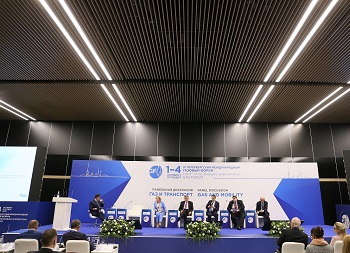
Infrastructure, laws and finance – these are the three words to describe the needs of the gas engine fuel industry, its representatives gathered at the panel discussion GAS AND TRANSPORT on the last day of the 9th St. Petersburg International Gas Forum.
Elena Skoryna, Deputy Development CEO at Gazpromneft Marine Bunker LLC, told the discussion participants about switching maritime transport to liquefied natural gas (LNG), which is by now the only alternative ecological fuel available. According to her, large-scale shipping forwarders are currently renewing their fleets, and this trend can help LNG incorporate organically into the industry, as 65% of shipowners’ budgets are bunker fuel expenses that they are looking forward to cut somehow.
The speaker addresses the global experience of fleet reequipment, providing the case of the South Korea, which is getting ready to switch 140 vessels to LNG. She mentioned that Gazprom doesn’t just sit idly: today, a leasing company is establishing a bunkering station at the Baltic on their order. Moreover, they’ve signed a cooperation agreement with large-scale shipowners, who will fuel their vessels at the station.
Along with that, the company is developing a regulative base to ensure support of gas fuel introduction from the state.
Dmitry Rusanov, Head of the Division of Development and Management of the Liquefied Natural Gas Fleet at Sovcomflot PJSC, took on the subject of switching ships to LNG. He remarked that in the Baltic and the White Seas using highly sulphur fuel oil had been prohibited, and early or later all shipowners will have to consider switching their fleets to gas. Today, a single journey Primorsk-Rotterdam-Primorsk causes emission of 350 tons of СО2 into the atmosphere.
Sovcomflot has been cooperating with Shell since 2015. Last year, the first LNG Aframax vessel of the company performed bunkering with a Shell bunker barge, and then departed on its first commercial journey. Moreover, in October 2018 the first run following through Arctic waters took place. “There is no doubt that such equipment makes vessels much more expensive. A set of such equipment makes about 20% of the vessel cost,” Dmitry Rusanov resumed.
Alexander Shalatonov, Senior Engineer and Deputy CEO of Gazprom Gas-Engine Fuel LLC, told that pilot projects for switching to methane are being dynamically realized in the Rostov and Belgorod Regions. From 2019 to 2021, the amount of special fueling stations in each of those regions will reach 39. Currently, according to the speaker, there is a wide range of vehicles in Russia working on natural gas, with a total of 229 products, including 127 models of passenger transport, 36 – special machines, and 19 – light commercial vehicles.
Similar projects will be implemented in St. Petersburg, as well as the Leningrad and Kaliningrad Regions. The necessary agreements were signed at the Forum on October 3. Totally, the company signed 812 cooperation agreements with consumers. According to forecasts, sales of Gazprom’s gas will reach 1 bln m3 next year. The Ministry of Energy expects that by 2024 methane consumption will exceed 3 bln m3, the amount of fuelling facilities will exceed 1,000 stations, and the number of natural gas vehicles will reach 430 thousand. The speaker announced that in his opinion, wide spreading of gas fuel is restrained by high cost of fueling equipment and land use for fueling stations, as well as by absence of the state business incentives.
Rene Bauz, CEO of GazNat and President of the Global Gas Centre, told his colleagues about a tough system of penalties for СО2 emissions in Switzerland: if a driver exceeds the permitted limit even by 5 g, he will have to pay a fine of 1 thousand Swiss Francs. The speaker reminded that the European Union had developed an emission reduction strategy, according to which by 2021 emissions from one vehicle should be reduced down to 96 g, and by 2030 – to 60 g. According to him, their company managed to introduce gas engines in the car fleet of the Swiss Coca-Cola branch and some other regional companies. Currently, they are negotiating with Nestle and L’Oreal.
Alexey Fedotov, Director for Business Development at Yandex.Taxi LLC, told the audience that according to their calculations, all the vehicles of their taxi fleet monthly emit 640 t of carbon dioxide. Partners of Yandex.Taxi had 4,300 cars on methane in May 2019, and now they have 5,845. To engage drivers to switch to methane fuel, the company presents them with an economic reason: 35% of money spent by taxi drivers are for petroleum fuel, and switching to methane will cut those costs threefold.